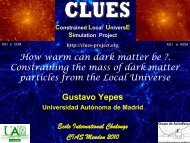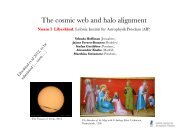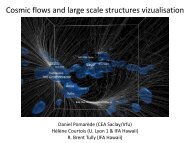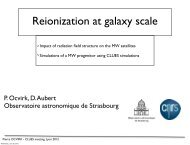The cosmic web in the GIMIC simulation - CLUES-Project
The cosmic web in the GIMIC simulation - CLUES-Project
The cosmic web in the GIMIC simulation - CLUES-Project
You also want an ePaper? Increase the reach of your titles
YUMPU automatically turns print PDFs into web optimized ePapers that Google loves.
<strong>The</strong> <strong>cosmic</strong> <strong>web</strong> <strong>in</strong> <strong>the</strong><br />
<strong>GIMIC</strong> <strong>simulation</strong><br />
Ofer Metuki<br />
Hebrew University<br />
<strong>CLUES</strong> meet<strong>in</strong>g 2013,<br />
La Cristalera
Motivation<br />
● We've known for a long time that<br />
environment affects galaxy formation<br />
and galaxy properties (Dressler 1980)
Motivation<br />
● We've known for a long time that<br />
environment affects galaxy formation<br />
and galaxy properties (Dressler 1980)<br />
● “Environment” is not well def<strong>in</strong>ed –<br />
observers and <strong>the</strong>orists use different<br />
def<strong>in</strong>itions
Motivation<br />
● We've known for a long time that<br />
environment affects galaxy formation<br />
and galaxy properties (Dressler 1980)<br />
● “Environment” is not well def<strong>in</strong>ed –<br />
observers and <strong>the</strong>orists use different<br />
def<strong>in</strong>itions<br />
● HODs and SAMs rely on <strong>the</strong> fact that<br />
all of <strong>the</strong> effect comes <strong>in</strong> <strong>in</strong>drectly<br />
through <strong>the</strong> halo mass (and accretion<br />
history)
<strong>The</strong> <strong>GIMIC</strong> <strong>simulation</strong><br />
● Re<strong>simulation</strong> of <strong>the</strong> Millenium run
<strong>The</strong> <strong>GIMIC</strong> <strong>simulation</strong><br />
● Re<strong>simulation</strong> of <strong>the</strong> Millenium run<br />
● 5 regions of 18-25 Mpc/h radius, with<br />
densities of -2 to +2 σ
<strong>The</strong> <strong>GIMIC</strong> <strong>simulation</strong><br />
● Re<strong>simulation</strong> of <strong>the</strong> Millenium run<br />
● 5 regions of 18-25 Mpc/h radius, with<br />
densities of -2 to +2 σ<br />
● Full gas dynamics, feedback but no<br />
AGN
<strong>The</strong> <strong>GIMIC</strong> <strong>simulation</strong><br />
● Re<strong>simulation</strong> of <strong>the</strong> Millenium run<br />
● 5 regions of 18-25 Mpc/h radius, with<br />
densities of -2 to +2 σ<br />
● Full gas dynamics, feedback but no<br />
AGN<br />
● Intermediate resolution -<br />
●<br />
M DM =5.3×10 7 M ⊙<br />
M gas =1.17×10 7 M ⊙
<strong>The</strong> <strong>GIMIC</strong> <strong>simulation</strong><br />
● Re<strong>simulation</strong> of <strong>the</strong> Millenium run<br />
● 5 regions of 18-25 Mpc/h radius, with<br />
densities of -2 to +2 σ<br />
● Full gas dynamics, feedback but no<br />
AGN<br />
● Intermediate resolution -<br />
M M gas =1.17×10 7 DM =5.3×10 7 M ⊙<br />
M ⊙<br />
● Star formation, stellar feedback,<br />
radiative cool<strong>in</strong>g, chemodynamics
<strong>The</strong> <strong>GIMIC</strong> <strong>simulation</strong><br />
● Halos and subhalos are found us<strong>in</strong>g<br />
AHF
<strong>The</strong> <strong>GIMIC</strong> <strong>simulation</strong><br />
● Halos and subhalos are found us<strong>in</strong>g<br />
AHF<br />
● We only take halos > 10 10 M ⊙ for <strong>the</strong><br />
sake of numerical convergence
<strong>The</strong> <strong>GIMIC</strong> <strong>simulation</strong><br />
● Halos and subhalos are found us<strong>in</strong>g<br />
AHF<br />
● We only take halos > 10 10 M ⊙<br />
● Galaxies are def<strong>in</strong>ed to be everyth<strong>in</strong>g<br />
with<strong>in</strong> 10% of Rvir
<strong>The</strong> <strong>GIMIC</strong> <strong>simulation</strong><br />
● Halos and subhalos are found us<strong>in</strong>g<br />
AHF<br />
● We only take halos > 10 10 M ⊙<br />
● Galaxies are def<strong>in</strong>ed to be everyth<strong>in</strong>g<br />
with<strong>in</strong> 10% of Rvir<br />
● Satellite galaxies reside <strong>in</strong> subhalos
<strong>The</strong> <strong>GIMIC</strong> <strong>simulation</strong><br />
● Halos and subhalos are found us<strong>in</strong>g<br />
AHF<br />
● We only take halos > 10 10 M ⊙<br />
● Galaxies are def<strong>in</strong>ed to be everyth<strong>in</strong>g<br />
with<strong>in</strong> 10% of Rvir<br />
● Satellite galaxies reside <strong>in</strong> subhalos<br />
● Galaxies (and satellites) must have at<br />
least 10 star particles
<strong>The</strong> <strong>GIMIC</strong> <strong>simulation</strong>
<strong>The</strong> parent halo mass function<br />
● Changes with <strong>web</strong> –<br />
effect of environment<br />
● Knots control high<br />
masses, <strong>the</strong>n filaments,<br />
<strong>the</strong>n sheets
<strong>The</strong> (central) lum<strong>in</strong>osity function<br />
● Very similar behaviour<br />
to mass function<br />
● Unrealistic “bump” a<br />
feature of <strong>the</strong> <strong>GIMIC</strong><br />
<strong>simulation</strong>s
Subhalo mass function<br />
A clear trend with <strong>the</strong><br />
“<strong>web</strong> sequence”,<br />
matches number of<br />
positive eigenvalues
Satellite lum<strong>in</strong>osity function<br />
Same trend with <strong>web</strong><br />
sequence as <strong>in</strong> <strong>the</strong><br />
subhalos
Subhalo / satellite numbers<br />
Subhalos<br />
Satellites
Baryon fraction <strong>in</strong> lum<strong>in</strong>ous halos<br />
Plots sit right on top of<br />
each o<strong>the</strong>r!<br />
Th<strong>in</strong>gs change with<br />
halo mass, but for a<br />
given halo mass, no<br />
change between <strong>web</strong><br />
elements.
L/M<br />
L/Mvir<br />
L/Mbar
Specific star formation rate<br />
● Higher mass halos<br />
have later SFR peak<br />
● Highest mass b<strong>in</strong><br />
behaves differently, but<br />
with<strong>in</strong> each mass b<strong>in</strong><br />
almost no change<br />
between <strong>web</strong> elements
Conclusions<br />
●<br />
●<br />
●<br />
●<br />
<strong>The</strong> <strong>web</strong> affects mass functions – <strong>the</strong><br />
higher a halo is on <strong>the</strong> “<strong>web</strong> sequence”,<br />
<strong>the</strong> more massive it is likely to be<br />
Lum<strong>in</strong>osity functions behave close to<br />
mass functions<br />
Subhalos show a clear trend with <strong>web</strong><br />
sequence<br />
Satellite galaxies also follow <strong>the</strong> subhalos<br />
<strong>the</strong>y reside <strong>in</strong>
Conclusions<br />
●<br />
●<br />
O<strong>the</strong>r galaxy parameters depend on <strong>the</strong>ir<br />
host halo mass, but not on <strong>the</strong>ir <strong>web</strong><br />
element<br />
Good news for SAMs and HODS!







![Constrained Local Universe Simulations [pdf, 19 MB] - CLUES-Project](https://img.yumpu.com/24321200/1/190x135/constrained-local-universe-simulations-pdf-19-mb-clues-project.jpg?quality=85)
